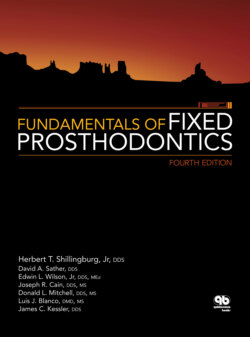Читать книгу Fundamentals of Fixed Prosthodontics - James C. Kessler - Страница 38
На сайте Литреса книга снята с продажи.
Mutually protected occlusion
ОглавлениеMutually protected occlusion is also known as canine-protected occlusion or organic occlusion. It had its origin in the work of D’Amico,48 Stuart,49,50 Stallard and Stuart,27 and Lucia51 and the members of the Gnathological Society. They observed that in many mouths with a healthy periodontium and minimum wear, the teeth were arranged so that the overlap of the anterior teeth prevented the posterior teeth from making any contact on either the working or the nonworking side during mandibular excursions. This separation from occlusion was termed disocclusion. According to this concept of occlusion, the anterior teeth bear the entire load, and the posterior teeth are disoccluded in any excursive position of the mandible. The desired result is an absence of frictional wear.
The position of maximal intercuspation coincides with the optimal condylar position of the mandible. All posterior teeth are in contact with the forces being directed along their long axes. The anterior teeth either contact lightly or are very slightly out of contact (approximately 25 microns), relieving them of the obliquely directed forces that would be the result of anterior tooth contact. As a result of the anterior teeth protecting the posterior teeth in all mandibular excursions and the posterior teeth protecting the anterior teeth at the intercuspal position, this type of occlusion came to be known as a mutually protected occlusion. This arrangement of the occlusion is probably the most widely accepted because of its ease of fabrication and greater tolerance by patients.
However, to reconstruct a mouth with a mutually protected occlusion, it is necessary to have anterior teeth that are periodontally healthy. In the presence of anterior bone loss or missing canines, the mouth should probably be restored to group function (unilateral balance). The added support of the posterior teeth on the working side will distribute the load that the anterior teeth may not be able to bear. The use of a mutually protected occlusion is also dependent on the orthodontic relationship of the opposing arches. In either a Class II or a Class III malocclusion (Angle), the mandible cannot be guided by the anterior teeth. A mutually protected occlusion cannot be used in a situation of reverse occlusion, or crossbite, in which the maxillary and mandibular facial cusps interfere with each other in a working-side excursion.
Fig 2-16 A shallow protrusive condylar inclination requires short cusps (a), while a steeper path permits the cusps to be longer (b).
